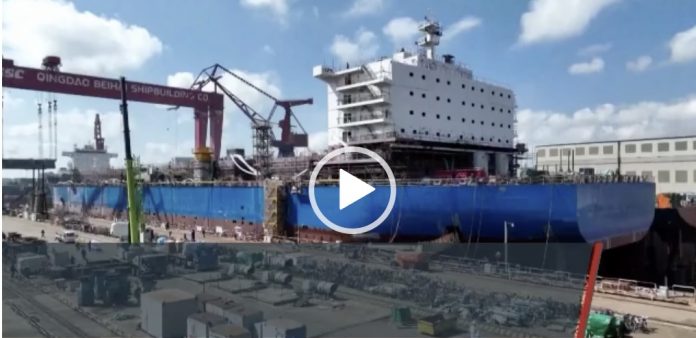China’s first 150,000 ton offshore fish farming vessel set to enter operation in 2025.
China is set to expand its offshore aquaculture ambitions with the launch of Guoxin 2-1, a 150,000-deadweight tonnage (DWT) smart aquaculture vessel, currently under construction in Qingdao, Shandong Province. The floating fish farm, developed by Guoxin China Shipbuilding Qingdao Marine Technology, is expected to become operational in 2025.
Measuring 245 meters in length and 45 meters in width, Guoxin 2-1 is the largest aquaculture vessel ever built, featuring 15 tanks, each larger than two standard swimming pools. The vessel is an upgraded version of Guoxin 1, the world’s first large-scale fish farming ship, which has been in operation since 2022. The new vessel incorporates over 160 optimizations, including improved energy efficiency and functional layout enhancements.
Expanding China’s Offshore Aquaculture Model
Guoxin 1 has served as a proof of concept, having traveled 14,000 nautical miles across the Yellow Sea, East China Sea, and South China Sea since its launch. The vessel has produced 2,700 tonnes of yellow croaker, capitalizing on its ability to navigate different waters to match optimal temperature conditions for fish cultivation.
Building on this experience, Guoxin 2-1 introduces an improved fish fry delivery system. “While retaining the hoisting method, we have employed a side-entry approach that allows fish fry to be transported directly into the breeding cabins through new hull openings,” said Tian Neidong, project director at Guoxin China Shipbuilding Qingdao Marine Technology. “This significantly enhances efficiency and reduces damage rates.”
‘No way this could work’: Why a former Mowi boss changed his mind on tanker farming scheme
Advanced Monitoring and Increased Production Efficiency
The vessel is equipped with an integrated control system, with more than 2,000 sensors monitoring water temperature, quality, and oxygen levels in real time. Data is transmitted to both the ship’s onboard monitoring room and a shore-based control center, allowing for remote management and operational adjustments.
The fish rearing density in Guoxin 2-1’s closed-containment tanks is reported to be four to six times higher than traditional sea cages, while the aquaculture cycle is reduced by 30%. The company also claims that the vessel enhances fish survival rates and growth efficiency, improving overall production yields.
Guoxin’s floating farms form part of China’s broader strategy to industrialize offshore aquaculture, with plans to build 50 such vessels over the next five years. The model has drawn international attention, particularly from European firms exploring tanker-based salmon farming, as an alternative to land-based recirculating aquaculture systems (RAS) and traditional nearshore farming.
Guoxin 2-1 is expected to be delivered in late 2025, with additional vessels, including those designed for cold-water species such as Atlantic salmon, currently in development.


